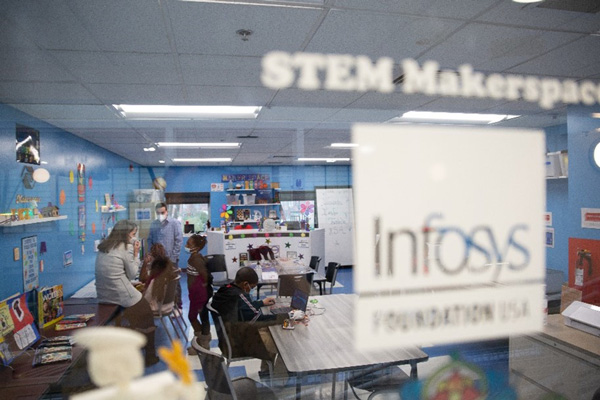Makerspaces: Building the Next Generation of Computer Scientists
By James Mazzullo | April 05, 2022

“Well, that just means you need to keep trying until you get it right or until you have to go home but then you can just try it again tomorrow.” These were the kind, motivating words of a fourth-grade student at the Asylum Hill - Boys and Girls Club of Hartford cheering me on after I was unable to successfully complete a circuit in their STEAM makerspace.
As a new member of the Infosys Foundation USA team, I had the good fortune to accompany our Executive Director to visit two of the nine Boys and Girls Club locations in Hartford, Connecticut last month to see the students in action. The first location, Asylum Hill, is home to an innovative makerspace that provides the students with a creative STEAM experience. Sponsored by a grant from the Foundation in 2019, this room was designed to inspire students to engage in STEAM and computer science through creative means. The second makerspace that will be added to the Joseph D. Lapenta Northwest Boys & Girls Club will also have a very similar design, with the intention of opening the eyes of young people to the thinking and approaches of computer science thru making, by giving them access to computers, tablets, circuits, 3D printers, T-shirt designer, etc. The state-of-the-art technology not only gives students an opportunity to engage in technology; but also allows them to invent, learn, and create in a manner that will shape them for the rest of their lives.
Our mission at Infosys Foundation USA is to expand access to computer science and maker education in K-12 public schools across the United States, with a particular focus on those communities most in need. A major part of that effort is identifying new and creative ways to inspire students to begin engaging with computer science and STEM at a young age. Sparking an interest in computer science is difficult for younger students, as technology can conjure up feelings of boredom or frustration. To create the next generation of computing professionals, we must first break that stereotype and show young people how truly accessible computational thinking can be.
Representation is incredibly important for these students, as we recognized only about 1% of computer science professionals in 2020 are black. Not only do black students need to be given equal access to the knowledge and technology to succeed in computer science; but they also need to see that a career in that field is a possibility for them. That representation doesn’t even need to reach adult role models. For instance, if a 5th grade student at the BGCH sees a 7th grade student engaging in activities in the makerspace, they will be inspired to make and create as well. A recent study of U.S. students in grades 5-12 reveals role models are highly correlated with students’ persistence on their career journey. Providing an opportunity for some will inspire the rest.
While preparing for an interview in the art room next door, Executive Director Kate Maloney pointed out the words “Do Not Enter” painted in ominous red paint on the door leading into the makerspace. After a heartfelt discussion with Debra Gonzalez, the STEAM Director at the club, we discovered that the paint reflects a barrier to the art room from before the makerspace was built. Now, Debra purposefully keeps the door open – to convey to the students the intersection of art, creativity, innovation of STEAM. The message is to convey there is no limit to what the students can create when they’re given the chance to shine. “Do Not Enter” may mean a lot of different personal things for the students of the Boys and Girls Club of Hartford but for me, it illustrated innovative ways we can inspire students to take advantage of their opportunities and reach their potential. We may be able to provide them with the tools necessary to succeed but the real hurdle is creating an environment where the students want to engage with those tools.
Having never been to a makerspace before, the one word that came to me as I watched the young students completely enthralled in circuit making, Ozobot design, computer games, etc. was: opportunity. Having grown up in an incredibly well-resourced public school system, these tools were always readily accessible to me and admittedly, I took them for granted. Growing up, my classmates and I were given countless opportunities to succeed in this field, hence the fact that 67% of computer science professionals are white. Some of the students in the Hartford school system aren’t given a single opportunity to succeed but, after seeing the ones who are lucky enough to find themselves at the Boys and Girls Clubs of Harford, I know this one thing to be true: they won’t stop trying until they succeed… or until they have to go home for the night.

